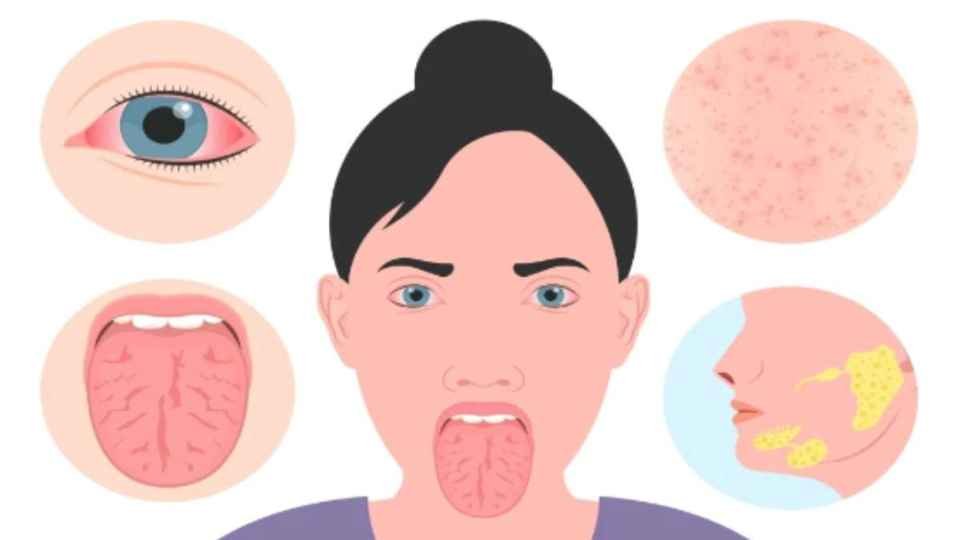Understanding Sjögren’s Syndrome: Causes, Symptoms, and Treatment
Sjögren’s Syndrome (SS) is a multifaceted autoimmune disorder that often lurks in the shadows of medical awareness despite its widespread impact. This chronic condition takes aim at the body’s moisture-producing glands, unleashing a cascade of symptoms that significantly disrupt daily life. In this exploration, we embark on a journey to decipher the enigmatic nature of SS, shedding light on its origins, manifestations, and therapeutic approaches.

Unraveling the Origins
At the heart of Sjögren’s Syndrome lies a malfunction within the immune system, where the body’s defense mechanisms mistakenly target its own tissues. This autoimmune assault predominantly affects the exocrine glands responsible for secreting moisture, such as the salivary and lacrimal glands. While the exact trigger remains elusive, a combination of genetic predisposition and environmental factors is believed to ignite the immune system’s misdirected response. Hormonal imbalances and viral infections have also been implicated in the onset of SS, adding layers to its intricate etiology.
Manifestations of Dryness
Dryness serves as the hallmark of Sjögren’s Syndrome, manifesting predominantly in the eyes and mouth. Individuals afflicted by SS often experience persistent dry eyes, accompanied by sensations of grittiness and irritation. Similarly, the mouth becomes parched, leading to difficulty swallowing, altered taste perception, and an increased susceptibility to dental decay. Beyond these focal points, SS can extend its reach to other moisture-dependent organs, triggering symptoms such as vaginal dryness, dry skin, and dryness of the respiratory and digestive tracts.
Beyond Dryness: Unveiling Systemic Complications
While dryness serves as a pervasive symptom, Sjögren’s Syndrome is not confined solely to the eyes and mouth. The autoimmune rampage can infiltrate various organ systems, giving rise to a spectrum of systemic complications. Patients with SS may encounter joint pain and inflammation, mimicking symptoms of rheumatoid arthritis. Neurological manifestations, including peripheral neuropathy and cognitive dysfunction, may also ensue, contributing to the disease’s multifaceted nature. Furthermore, SS heightens the risk of developing lymphoma, underscoring the grave implications of this seemingly innocuous disorder.
Navigating Treatment Terrain
Amidst the labyrinth of Sjögren’s Syndrome, treatment endeavors aim to alleviate symptoms, mitigate disease progression, and enhance overall quality of life. Therapeutic strategies often revolve around symptomatic relief, with artificial tears and saliva substitutes offering respite from dryness-related discomfort. Immunosuppressive agents may be prescribed to temper the immune system’s hyperactivity, while anti-inflammatory medications combat systemic inflammation. Additionally, targeted therapies and disease-modifying agents hold promise in addressing the underlying autoimmune pathology, heralding a new era of personalized treatment approaches.
What is Sjögren’s Syndrome?
Sjögren’s Syndrome stands as a testament to the complex interplay between the immune system and the body’s tissues. In this autoimmune disorder, the immune system, typically tasked with defending the body against harmful invaders, turns traitor, launching an assault on the very glands responsible for producing moisture. At its core, Sjögren’s Syndrome is a condition characterized by a relentless attack on the salivary and tear glands, resulting in a myriad of debilitating symptoms.
The Immunological Onslaught:
In Sjögren’s Syndrome, the immune system mistakenly identifies the moisture-producing glands—primarily the salivary and lacrimal glands—as foreign entities and mounts an inflammatory response against them. This onslaught leads to progressive damage and destruction of the glandular tissue, impairing their ability to produce saliva and tears.
Dry Eyes and Mouth:
The hallmark symptoms of Sjögren’s Syndrome manifest in the form of dry eyes and dry mouth, a consequence of reduced tear and saliva production. Patients often describe the sensation of gritty, burning eyes, coupled with difficulty swallowing and speaking due to decreased saliva. These symptoms not only cause discomfort but also pose significant challenges to daily activities such as eating, speaking, and even sleeping.
Beyond Dryness:
However, the impact of Sjögren’s Syndrome extends far beyond mere dryness. The systemic nature of this autoimmune disorder means that it can affect various organs and systems throughout the body. Patients may experience joint pain and swelling, muscle weakness, chronic fatigue, and cognitive difficulties. Additionally, Sjögren’s Syndrome increases the risk of developing other autoimmune conditions, such as rheumatoid arthritis and lupus.
Diagnostic Challenges:
Diagnosing Sjögren’s Syndrome can be challenging, as its symptoms often overlap with those of other conditions. A comprehensive evaluation, including clinical examination, blood tests measuring antibodies associated with the disease, and specialized tests assessing saliva and tear production, is essential for accurate diagnosis.
Management and Treatment:
While there is no cure for Sjögren’s Syndrome, treatment focuses on alleviating symptoms and preventing complications. Moisture replacement therapies, such as artificial tears and saliva substitutes, help combat dryness in the eyes and mouth. Immunosuppressive medications may be prescribed to reduce inflammation and control the autoimmune response. Additionally, lifestyle modifications, such as staying hydrated and avoiding triggers that exacerbate symptoms, play a crucial role in managing the condition.
Empowering Patients:
Living with Sjögren’s Syndrome requires a multifaceted approach that goes beyond medical interventions. Education and support are paramount in empowering patients to cope with the challenges posed by the disease. Support groups, counseling, and resources that provide practical tips for managing symptoms and improving quality of life can make a significant difference for individuals navigating life with Sjögren’s Syndrome.
Causes of Sjögren’s Syndrome:
Sjögren’s Syndrome, a perplexing autoimmune condition, continues to baffle researchers as they strive to uncover the intricate web of factors underlying its onset. While the exact etiology remains elusive, a convergence of genetic predisposition, environmental influences, and hormonal imbalances is believed to orchestrate the development of this debilitating disorder.
Genetic Predisposition:
One cornerstone of Sjögren’s Syndrome lies within the intricate blueprint encoded within our genes. Evidence suggests a genetic predisposition, with certain genetic variations predisposing individuals to autoimmune diseases, including Sjögren’s Syndrome. Family studies have shown an increased risk among relatives of individuals affected by autoimmune conditions, highlighting the role of genetic susceptibility in disease development.
Environmental Triggers:
While genetics may set the stage, environmental triggers serve as the catalyst, igniting the autoimmune cascade in susceptible individuals. Viral infections, particularly those involving the salivary glands, have been implicated as potential triggers for Sjögren’s Syndrome. Viruses such as Epstein-Barr virus (EBV) and hepatitis C virus (HCV) have been the focus of research due to their ability to incite immune dysregulation and inflammation, ultimately priming the immune system for an autoimmune assault.
Hormonal Influences:
The intricate interplay between hormones and the immune system adds another layer of complexity to the pathogenesis of Sjögren’s Syndrome. The condition predominantly affects women, with a female-to-male ratio of approximately 9:1, suggesting a potential role for hormonal factors. Fluctuations in sex hormones, particularly estrogen, have been implicated in modulating immune responses and may contribute to the increased prevalence of Sjögren’s Syndrome in women.
Immunological Dysregulation:
At the heart of Sjögren’s Syndrome lies a breakdown in immune tolerance, where the immune system loses its ability to distinguish between self and non-self, launching an attack on the body’s own tissues. Dysregulation of immune cells, including B cells, T cells, and dendritic cells, results in the production of autoantibodies and pro-inflammatory cytokines, driving the destruction of moisture-producing glands and the subsequent manifestation of clinical symptoms.
Symptoms of Sjögren’s Syndrome:
The symptoms of Sjögren’s Syndrome can vary widely among individuals and may include:
1. Dry Eyes
Persistent dryness, irritation, and a gritty sensation in the eyes are common symptoms of Sjögren’s Syndrome. This condition occurs when the glands that produce tears are affected, leading to inadequate lubrication of the eyes. As a result, individuals may experience discomfort, redness, and blurry vision.
2. Dry Mouth
Difficulty swallowing, speaking, and tasting are hallmark symptoms of Sjögren’s Syndrome-induced dry mouth. Decreased saliva production can lead to dryness of the oral cavity, causing discomfort and difficulties in daily activities such as eating and speaking. Additionally, the lack of saliva can increase the risk of dental decay and gum disease.
3. Dental Decay
Sjögren’s Syndrome is associated with an increased risk of tooth decay and gum disease due to reduced saliva flow. Saliva plays a crucial role in oral health by helping to cleanse the mouth, neutralize acids, and remineralize teeth. With diminished saliva production, individuals with Sjögren’s Syndrome may experience more rapid dental decay and a higher incidence of cavities and gum inflammation.
4. Fatigue
Chronic fatigue and weakness are prevalent symptoms of Sjögren’s Syndrome that can significantly impact daily functioning. Despite adequate rest, individuals may experience persistent tiredness and a lack of energy, leading to decreased productivity and overall quality of life. Fatigue in Sjögren’s Syndrome is often multifactorial, stemming from factors such as disrupted sleep due to dryness-related discomfort and underlying autoimmune processes.
5. Joint Pain
Pain and stiffness in the joints, resembling symptoms of arthritis, are frequently reported by individuals with Sjögren’s Syndrome. Joint pain can affect various parts of the body, including the wrists, knees, and ankles, and may be accompanied by swelling and reduced range of motion. While the exact mechanisms underlying joint involvement in Sjögren’s Syndrome are not fully understood, inflammation and immune dysregulation likely play significant roles.
6. Dry Skin and Skin Rashes
Dry skin and skin rashes can occur in individuals with Sjögren’s Syndrome, further adding to the array of symptoms associated with this condition. Dryness of the skin may lead to itching, flakiness, and discomfort, while skin rashes can manifest as redness, irritation, or even lesions. These dermatological manifestations may result from systemic inflammation, autoimmune processes, or secondary effects of reduced moisture levels in the skin.
7. Vaginal Dryness
Dryness and discomfort in the vaginal area, particularly in women, are common symptoms of Sjögren’s Syndrome. Decreased lubrication can lead to pain during intercourse, itching, and irritation, impacting sexual function and overall quality of life. Vaginal dryness in Sjögren’s Syndrome is often attributed to reduced secretions from the mucous membranes, similar to the dryness experienced in other parts of the body.
In addition to these primary symptoms, Sjögren’s Syndrome may also cause complications affecting other organs, such as the lungs, kidneys, and nervous system.
Treatment of Sjögren’s Syndrome:
While Sjögren’s Syndrome has no cure, various treatment options can help alleviate symptoms and improve quality of life for individuals affected by the condition. These treatment approaches typically target the management of dryness-related symptoms, inflammation, and autoimmune activity.
1. Eye Care
- Artificial Tears and Lubricating Eye Drops: These over-the-counter or prescription eye drops provide lubrication to relieve dryness, irritation, and discomfort in the eyes. They help maintain moisture and protect the ocular surface.
2. Oral Health Management
- Saliva Substitutes and Moisturizing Agents: Products such as saliva substitutes, oral moisturizing gels, and sugar-free gum can help alleviate dry mouth symptoms by providing lubrication and stimulating saliva production.
- Frequent Sips of Water: Drinking water regularly can help keep the oral cavity moist and reduce discomfort associated with dry mouth.
3. Medications
- Nonsteroidal Anti-inflammatory Drugs (NSAIDs): NSAIDs may be prescribed to reduce inflammation and alleviate pain associated with joint symptoms in Sjögren’s Syndrome.
- Corticosteroids: These anti-inflammatory medications may be prescribed to manage more severe inflammation in various organs affected by Sjögren’s Syndrome.
- Immunosuppressive Drugs: Drugs such as methotrexate, cyclosporine, or azathioprine may be used to suppress the overactive immune response and reduce autoimmune activity in Sjögren’s Syndrome. These medications are typically reserved for cases with significant organ involvement or when other treatments are ineffective.
4. Lifestyle Modifications
- Oral Hygiene: Maintaining good oral hygiene practices, including regular brushing, flossing, and dental check-ups, is essential to prevent dental decay and gum disease associated with dry mouth.
- Humidifiers: Using humidifiers in indoor environments can add moisture to the air, which may help alleviate dryness symptoms, especially during dry or winter months.
- Avoiding Triggers: Identifying and avoiding triggers that exacerbate symptoms, such as dry or windy environments, smoke, and certain medications, can help manage Sjögren’s Syndrome effectively.
5. Symptom Management
- Pain Management: In addition to NSAIDs and corticosteroids, other pain management strategies such as physical therapy, acupuncture, or gentle exercise may be beneficial for individuals experiencing joint pain and stiffness.
- Fatigue Management: Strategies to manage fatigue may include pacing activities, prioritizing tasks, practicing relaxation techniques, and ensuring adequate sleep hygiene.
6. Regular Monitoring
- Medical Follow-up: Regular monitoring by healthcare professionals, including rheumatologists, ophthalmologists, and dentists, is crucial for assessing disease activity, managing symptoms, and preventing complications associated with Sjögren’s Syndrome.
In severe cases where Sjögren’s Syndrome affects other organs, additional treatment may be necessary to manage complications and improve quality of life.
Conclusion:
Sjögren’s Syndrome is a chronic autoimmune disease that can significantly impact the quality of life for those affected. By understanding its causes, symptoms, and available treatment options, individuals living with Sjögren’s Syndrome can better manage their condition and seek appropriate medical care. Increased awareness and support for research are essential in improving the diagnosis and treatment of this often overlooked autoimmune disorder. If you or someone you know is experiencing symptoms suggestive of Sjögren’s Syndrome, it’s important to consult a healthcare professional for proper evaluation and management.
Top 20 FAQs about Understanding Sjögren’s Syndrome: Causes, Symptoms, and Treatment
- What is Sjögren’s Syndrome? Sjögren’s Syndrome is a chronic autoimmune disorder characterized by inflammation and dysfunction of the glands that produce tears and saliva, leading to symptoms of dry eyes and dry mouth, among others.
- What causes Sjögren’s Syndrome? The exact cause of Sjögren’s Syndrome is unknown, but it is believed to involve a combination of genetic, environmental, and immunological factors.
- Is Sjögren’s Syndrome hereditary? While there is a genetic predisposition to Sjögren’s Syndrome, it is not directly inherited in a simple Mendelian manner. Having a family member with an autoimmune disease may increase the risk of developing Sjögren’s Syndrome.
- What are the common symptoms of Sjögren’s Syndrome? Common symptoms include dry eyes, dry mouth, fatigue, joint pain, dry skin, and vaginal dryness.
- How is Sjögren’s Syndrome diagnosed? Diagnosis often involves a combination of medical history, physical examination, and various tests including blood tests, eye tests, salivary gland biopsy, and imaging studies.
- Is there a cure for Sjögren’s Syndrome? Currently, there is no cure for Sjögren’s Syndrome, but treatment focuses on symptom management and preventing complications.
- What are the treatment options for Sjögren’s Syndrome? Treatment options include artificial tears and lubricating eye drops, saliva substitutes, medications such as NSAIDs and immunosuppressants, lifestyle modifications, and regular monitoring.
- Can Sjögren’s Syndrome affect organs other than the eyes and mouth? Yes, Sjögren’s Syndrome can affect various organs and systems in the body, including the joints, skin, lungs, kidneys, and nervous system.
- Is Sjögren’s Syndrome associated with other autoimmune diseases? Yes, Sjögren’s Syndrome often coexists with other autoimmune diseases such as rheumatoid arthritis, lupus, and scleroderma.
- Does Sjögren’s Syndrome increase the risk of certain complications? Sjögren’s Syndrome may increase the risk of complications such as dental decay, gum disease, corneal ulcers, and lymphoma.
- Can hormonal changes affect Sjögren’s Syndrome symptoms? Yes, hormonal changes, particularly during menopause, can exacerbate symptoms of Sjögren’s Syndrome, such as vaginal dryness.
- Is there a specific diet recommended for individuals with Sjögren’s Syndrome? While there is no specific diet for Sjögren’s Syndrome, maintaining a balanced diet rich in fruits, vegetables, whole grains, and healthy fats can support overall health and well-being.
- Can stress worsen Sjögren’s Syndrome symptoms? Stress may exacerbate symptoms of Sjögren’s Syndrome, so stress management techniques such as relaxation exercises, mindfulness, and counseling may be beneficial.
- Is exercise recommended for individuals with Sjögren’s Syndrome? Yes, regular exercise can help improve joint mobility, reduce fatigue, and enhance overall well-being in individuals with Sjögren’s Syndrome. However, it’s important to consult with a healthcare professional before starting any exercise program.
- Can smoking worsen Sjögren’s Syndrome symptoms? Yes, smoking can worsen symptoms of Sjögren’s Syndrome and increase the risk of complications such as oral and lung problems. Quitting smoking is advisable for individuals with Sjögren’s Syndrome.
- Can Sjögren’s Syndrome affect fertility? Sjögren’s Syndrome may impact fertility, particularly in women with vaginal dryness and decreased lubrication. However, fertility issues can often be addressed with appropriate medical interventions.
- Is it safe to use contact lenses if I have Sjögren’s Syndrome? Contact lens use may be challenging for individuals with dry eyes due to Sjögren’s Syndrome. However, with proper care and lubricating eye drops, some individuals may tolerate contact lenses.
- Are there support groups available for individuals with Sjögren’s Syndrome? Yes, there are various support groups, online forums, and advocacy organizations dedicated to supporting individuals living with Sjögren’s Syndrome and their families.
- Can Sjögren’s Syndrome affect mental health? Yes, coping with the chronic symptoms and challenges of Sjögren’s Syndrome can impact mental health, leading to stress, anxiety, and depression. Seeking support from healthcare professionals or mental health specialists is important.
- Is research ongoing for new treatments for Sjögren’s Syndrome? Yes, ongoing research aims to better understand the underlying mechanisms of Sjögren’s Syndrome and develop new treatment approaches, including targeted therapies and immunomodulatory agents. Participation in clinical trials may be an option for eligible individuals.
Register for My Upcoming Masterclass HERE
See You in the Live Masterclass
Sunil Chaudhary stands as a preeminent global Leading digital coach, boasting a diverse clientele hailing from over 50 nations. Renowned for his prowess as an exemplary SEO expert, business automation coach, and landing page authority, Chaudhary also holds the distinction of being esteemed as the finest business coach in India. Beyond technical domains, he imparts invaluable insights into mindset, success, and life skills, thus encompassing a holistic approach to mentorship.
Join FREE Courses HERE
Know The Author:
 Sunil Chaudhary aka Suniltams Guruji is India’s Leading Digital Coach. He provides complete Digital Skill Development Coaching with great support. Sunil has trained more than 25000 students and helped more than 1100 businesses so far. Sunil is a well-known face across the world for Digital Coaching.
Sunil Chaudhary aka Suniltams Guruji is India’s Leading Digital Coach. He provides complete Digital Skill Development Coaching with great support. Sunil has trained more than 25000 students and helped more than 1100 businesses so far. Sunil is a well-known face across the world for Digital Coaching.
Digital Success Coach | Best SEO Coach India | Mindset Coach | Life Success Coach
Related posts:
 5 Tips to Beat the Heat in the Kitchen this Summer
5 Tips to Beat the Heat in the Kitchen this Summer
 Ayurvedic Medicine for Stomach Ulcer: A Natural Approach to Healing
Ayurvedic Medicine for Stomach Ulcer: A Natural Approach to Healing
 Weight Changes and Neck Swelling: Understanding the Connection
Weight Changes and Neck Swelling: Understanding the Connection
 Normal Blood Pressure: A Comprehensive Guide
Normal Blood Pressure: A Comprehensive Guide
 The Skinny on Weight Loss Bracelets: Do They Really Work?
The Skinny on Weight Loss Bracelets: Do They Really Work?
 Enjoy Sipping on Tender Coconut? Know Easy Tips to Clean, Store, and Reuse Its Outer Shell
Enjoy Sipping on Tender Coconut? Know Easy Tips to Clean, Store, and Reuse Its Outer Shell
 Smoking in an AC Room: How It Can Affect Your Heart, Brain, and Kidney
Smoking in an AC Room: How It Can Affect Your Heart, Brain, and Kidney
 Skim Milk vs. Whole Milk: Which is Healthier?
Skim Milk vs. Whole Milk: Which is Healthier?
 Love Donuts? Try These 5 Delectable Varieties to Satisfy Your Sweet Tooth This National Donuts Day
Love Donuts? Try These 5 Delectable Varieties to Satisfy Your Sweet Tooth This National Donuts Day







